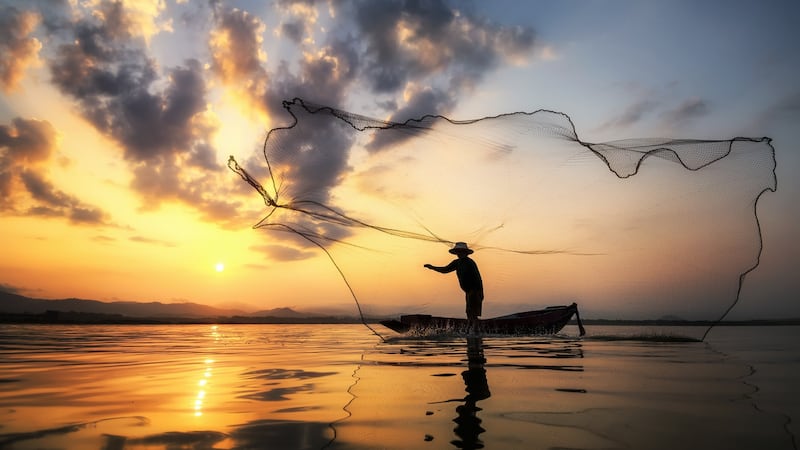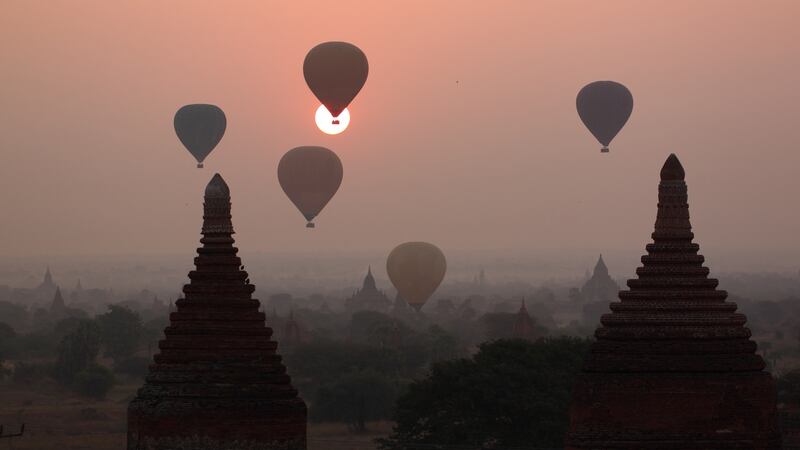I spent a couple of weeks in Myanmar recently and was enchanted. Despite living through war and dictatorship, the people are warm, welcoming and courageous and now so full of hope. The women decorate their faces with a white paste made from the bark of the thanaka tree and many men wear the longhi, a long, skirt-like garment.
The countryside is dotted with pagodas, stupas and monasteries. Buddhist monks and nuns in flowing wine-and-pink robes are everywhere, an estimated 20,000 in Myanmar (formerly Burma). At dawn, they walk through the streets with their alms bowls, collecting rice and offerings, a moving sight.
Our adventure began in the former capital, Yangon, originally Rangoon. It is now a bustling city of crazy contrasts as Myanmar takes its first tentative steps towards democracy.


Burmese food is an intriguing but unique melange of influences from neighbouring China, India and Thailand and some dishes that date back to British rule.
Yangon is street-food paradise, the Burmese seem to snack all day long. Little street stalls offer a mesmerising selection of kebabs, dumplings, pakoras, samosas, noodle and tofu dishes and beautifully prepared tropical fruits, ready to eat.
Traditional Burmese teashops are very much part of the scene and provide more than a caffeinated kick, a variety of snacks as well as strong, sweet and sometimes spicy Burmese tea usually made with condensed milk. I particularly loved mohinga, a thick fish-and-shallot-based soup with round rice noodles often eaten for breakfast and Shan noodles in a spicy tomato based stew.
Burmese salads are sensational – tomato, aubergine, green mango, bean, tamarind leaf, even fish cakes and samosas are chopped in.
There is a fermented tea leaf salad with crunchy beans called laphet often served at the end of a meal, totally irresistible. I ate it at every opportunity and everyone's version seemed to be different but delicious. Included in one meal was a bowl of delicious sago and jaggery. Imagine using the word delicious and sago in the same sentence, but delicious it was. In fact I've been hunting for sago ever since my return.
People – and there are millions of them – sit on tiny, bright, plastic stools, about a foot high, around equally tiny, low tables on the pavement, tucking into little snacks. Several stalls we saw had a shallow bowl of broth in the centre surrounded by little bamboo skewers of pig offal – ear, snout, liver, tail, trotters. Five or six customers sat around helping themselves to whatever choice pieces they fancied and were billed according to the number of empty skewers.
Other ladies on Pansodan Street sold Burmese pancakes with coconut and little clay pots of delicious home-made yoghurt drizzled with jaggery. In my experience, street food is where one gets the authentic taste of a country.
We strolled through the Bogyoke Aung San Market and Kandawgyi Lake gardens, and hopped on to the Yangon circular line. This (very) slow train does a loop through the suburbs and outlying villages providing a unique behind-the-scenes view of local life. At every station, street food vendors pop on and off with baskets of tempting sweet and savoury snacks.
In the late afternoon, we took a sunset cruise on the Rangoon river. We were on quite a posh boat but there were lots of little timber skiffs drawing in their nets or ferrying people across to the other side. You could buy baskets of chickpea fritters to feed the seagulls somersaulting in the air to catch the treats.
Yangon’s most sacred and awe-inspiring site is the incredible gold Shwedagon temple that dominates the city skyline and attracts pilgrims from all over the world.
Ther are numerous Buddhas in different manifestations, many now with neon lights emanating from their heads – a rather disconcerting sight which the Burmese apparently love. Nonetheless a visit in the early morning or late afternoon is a must.
China town and 19th Street at night are other unforgettable experiences: people eating all kinds of unmentionable and unrecognisable things in restaurants and on street stalls. There are steaming bowls of dumplings and exotic Chinese delicacies, including toasted grasshoppers.
Durian are in season, a fruit that looks a bit like a dinosaur, smells utterly putrid but tastes sublime. There were also jackfruit and tons of water and honeydew melons, dragon fruit, cherimoya, mangosteen, rambutans, huge avocados and a fruit from Thailand I’ve never seen before with a scaly skin called snake fruit.
On a first trip, you'll want to include Mandalay, Bagan, perhaps a cruise on the Irrawaddy river and a boat trip on Lake Inle.
Our visit to Heho coincided with the five- day market, so called because the market alternates between different towns every five days.
The roads were crammed with covered wagons with frisky ponies, ancient tractors, home-made lorries with no cabs, motorbikes, tricycles and tuc-tucs delivering both customers and produce.
There were lots of unfamiliar foods, vats of fermented fish with a pungent smell, opium cakes, red rice and bean cakes, and piles of tropical vegetables and fruit.
I tasted several delicious little snacks, flakey pakoras and pennyworth tempura with a tamarind dip, and a couple of sticky rice confections. All this plus lots of complimentary green tea for a couple of kyats (the Myanmar currency).
Butchers sold every imaginable (and unimaginable) cut of meat and intestines, super fresh chicken – and I mean super fresh. You choose your live chicken, they chop the head off there and then, pluck it, eviscerate and chop it up, hey presto, you choose what bits you want or take it all. No wonder it’s so tough in most restaurants.
We drove down the mountain through stunning countryside to Nyaungshwe and hopped on to a long tail boat to explore Lake Inle where the ethnic Intha people live in a totally sustainable way.
They fish from flat-bottomed skiffs with traditional conical nets and propel the boats with their leg wrapped around the oar in the distinctive leg-rowing stance of the Intha people.
In the 18th century, their ancestors fled from persecution in Thailand but the local Shan chief refused to grant them land rights. So they built their houses on stilts on the edge of the lake and created ingenious floating gardens anchored to the lake bed with bamboo poles, where they grow tomatoes, gourds, cucumbers, squash and beans. The impressive fertility is maintained by composting and adding weed from the lake.
We went to an excellent cooking class and lunch at the Heritage Restaurant on an island on the edge of Inle Lake. The food, much of which came directly from their organic gardens, was really good. I tasted red tree ants, a local delicacy, very nutritious and delicious with a distinct lemony flavour.
On the way back, we visited a traditional hand-rolling cheroot factory and a fascinating weaving project in Dein, where they spin exquisitely fine silk thread from lotus root.
At the local Mingalar market in Nyaungsh, we and others around the country were given a glimpse into local life that no guidebook can. Apart from the artistically arranged produce, there were lots of tiny hardware stalls with pots and pans and implements made from recycled tin, bamboo baskets and beautifully crafted handmade knives and tools from one of the Intha villages. Here, too, I found many unfamiliar foods, chickpea greens, squash tendrils, Burmese pennyworth, pigeon peas and best of all, barbecued rice paddi rats which our guide told us are delicious with a beer or a glass of rice toddy.
Next, we were on the road to Mandalay, not quite as romantic and exotic a city as Rudyard Kipling’s poem conjures up, but nonetheless, an exotic history. Don’t miss the crazy Zegyo market, the remains of the king’s palace or the Shwenaudaw monastery. Travel outside the city to Inwa (Ava), the ancient capital of Myanmar.
We took a boat up the river and from there we were brought to the site on ramshackle ponies and carts, along a horrendously potholed road, but it was worth it to see the extraordinary Bagaya Kyaung, a pagoda made of 1,000 teak trees and the 60ft leaning Nan Myin Tower, part of Bagyidaw’s now-vanished palace complex.
Driving through the countryside is endlessly fascinating with oxen and, here and there, a small tractor ploughing the fields, women with little conical bamboo hats winnowing or planting rice in the paddies, pigs and chickens snuffling for food by the roadside, ponds full of lilies and lotus flowers, water buffalos, stalls selling sugar cane juice, brightly coloured snacks, freshly picked vegetables, pan-wrapped in betel leaves and lotto tickets.
Watermelons were piled high on the side of the road. There was lush tropical vegetation and bamboo-weaving workshops. The U Bein Bridge, the longest wooden bridge in the world, spanning the Amarapuras Taungmyo Lake is a wondrous site and the silhouette of Buddhist monks crossing with the sun setting behind is an irresistible photo opportunity.
The Old British Hill station at Pyin U Lwin, on the edge of the Shan Plateau is a two-hour drive from Mandalay along the road to China. Its altitude, at 1,200m, provided a cool retreat for the former British columnists to flee from the scorching sun in summer. The famous Kandawgyi Botanic Gardens are close by.
One of the highlights of our trip to Myanmar was a cruise on the Irrawaddy river. We boarded the beautiful teak Paukan boat from Sagaing. It was exquisitely relaxing as we just cruised along by the riverbank at a nice gentle pace, watching local farmers tending their crops of peanuts, sesame and corn. There was the odd bullock cart laden with grass, fisherman in tiny timber boats fishing as their ancestors must have done in that area for hundreds, maybe thousands of years.
Lots of little villages are tucked in between the palm trees along the riverbank. Here too, the timber and bamboo houses are on stilts: the river floods every year, covering the bank with rich silt that enhances the fertility of the soil so they can grow a variety of crops. We moored and clambered up the muddy bank to visit a little village where virtually everyone was involved in making clay water pots.
Finally, there was the temple town of Bagan, one of Myanmar’s most wondrous sites. More than 2,000 temples, shrines and stupas scattered over a 42sq km area. If you choose one special treat during your trip, take a balloon ride at dawn over the archaeological site. It is totally magical.
Even for well-seasoned travellers, floating over the 11th- and 12th-century pagodas in the misty morning light is an unforgettable experience.
Burmese food gets quite a bad rap but we had delicious things to eat everywhere – except in the fancy hotels. Lots of little roadside restaurants in Old Bagan serve simple but utterly delicious local food. You just sit at the table and they bring a huge bowl of rice and a succession of little dishes, one more intriguing than the next.
Possibly the best way to explore this awe-inspiring site is to hire a bike or one of the e-bikes but be careful of the crazy traffic and stray dogs.
It gets very hot in the early afternoon so you may want to just chill and then take a horse and cushioned cart ride in the early evening to see the sunset from the top of the Shwesandaw Pagoda or down by the Irrawaddy river. Locals selling delicious shrimp or sprat fritters while monks chant in a nearby temple all add to the atmosphere.
There’s so much more to see in Myanmar now. Go soon, some change is inevitable. I’m totally smitten and long to return.







